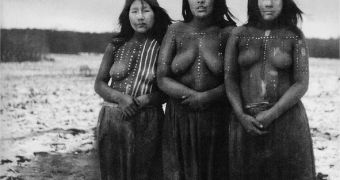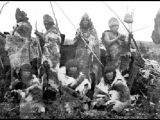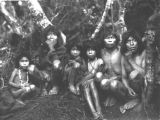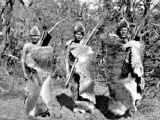One of the most primitive human groups on Earth were the native inhabitants of the Tierra del Fuego ("Land of Fire") island, at the southern tip of South America, a stormy, cold and inhospitable area, discovered by Magellan in 1520. The weather is cloudy almost all year long and violent storms are accompanied by tremendous showers, preceded by powerful hurricanes. The harsh clime is due to the freezing humid current, coming from southwest, from the Antarctica. The most powerful storms and winds occur in the summer. In the winter, weather is calmer, but the thick snow covers the ground for 5-6 months, and the temperatures drop to -20o C.
The low northern part of the Tierra del Fuego is covered by steppes. In the mountains, large glaciers form, descending towards deep fjords. The largest animal of the area is the guanaco (a wild relative of the lama and camel); water birds abound, from penguins to gannets, while the cold water harbor large amounts of fish and sea mammals (whales, elephant seals, fur seals, sea lions and various seal species). In the mountains, forests of austral beech (Notofagus), rich in ferns, mosses and likens appear.
Tierra del Fuego was inhabited by three unrelated groups: Ona, which lived by gathering wild fruits and guanaco hunt; Yahgan in islands south of the Isla Grande (Great Island) of Tierra del Fuego, and Alacaluf (inhabiting the Strait of Magellan - Brunswick Peninsula, Wellington, Santa In?s and Desolaci?n islands). The last two groups lived by gathering sea products and fishing. All these groups did not know farming, weaving, skin tanning, pottery and basket making. The fisherman groups did not know the fishing hook and nets, while the Onas, inhabiting an island surrounded by fish-rich waters, did not fish and nor even did they swim.
The Fuegian religion was based on the belief in an almighty supreme god, master and owner of all the things; he has no body and is very kind, guarding the moral law that punished the evils and reward the good deeds. Between the supreme god and the humans there are a lot of spirits, good or evil, which can be dominated only by the shaman via magic rites. Evil spirits cause diseases and death, but the shaman can cure the ill person by making the harmful spirit go out of the body; this is made through magic spells performed while reciting psalmodies and finally by rubbing the diseased body part. If all these fail, the shaman blows on the face of the diseased, sucking the pained portion and finishes by simulating the extraction of the cause of the harm: a small stone, a caterpillar or something similar. Shamans were very feared and respected, because besides curing, they were believed to also cause disease.
The Onas were very distinct from other Fuegians. They resembled the Natives that once inhabited Patagonia, and many agree they spoke a similar language. Those people, because of the large feet, gave the name of that area ("pata" means "leg" in Spanish). They were tall, men's height varying between 1.7 to 1.8 m (5.6 to 6 ft), with massive bodies, wide faces, large prominent noses and straight hair.
Instead, the Yahgans and Alacalufs were very short (male average height was of 1.55 m or 5 ft 2 in), with feeble bodies. The head had a receding forehead, a very wide nose and wavy hair. Today, Fuegian languages are extinct or on the verge of extinction, and few people of pure blood remained.
How can these racial differences be explained? Amerindians, Proto-Mongoloid people forming most of the Native of the Americas, entered the continents in three waves, 12,000 years ago. But the first inhabitants of America belonged to the Asian Negroid (Black) type, one of the first human groups to have moved out of Africa, perhaps 60,000 years ago. The 40,000 years old European Cro-Magnon could have been of this type.
12,000 years ago, Black Asians were the main inhabitants of India, Indochina, Indonesia, New Guinea, Melanesia and perhaps even eastern China (or the whole eastern Asia). Typical Black Asians are the Australian Aborigines, who entered Australia about 40,000 years ago, or the Papuans of New Guinea or Melanesians tribes in the western Pacific, who came there 21,000 years ago from Asia. Unlike African Blacks, these people have abundant beards, a lot of hair on the body, are shorter, have slimmer lips, a tilted front (not cambered), prominent eye ridge and aquiline noses. The hair is somewhat less kinky.
The Black Asians were seen as ones of the first colonizers of America after the discovery of 11,000-year old Brazilian skulls in 1974 in Lagoa Santa (Minas Gerais). They belonged to thick lipped and flat nosed Negroids (nothing to do with the Amerindians) which were 1.5 m (5 ft) tall. Further analysis of 15 fossil skulls discovered in Brazil, Colombia and Tierra del Fuego, dated 11,500 to 8,500 years ago, confirmed the hypothesis that, before the Proto-Mongoloid (Amerindian) stock, a previous migratory human wave reached Americas more than 12,000 years ago. These people were very similar to the Australian Aborigines, being characterized by a narrow and long skull, long face and small nose and eye sockets.
About 9,000 years ago, the Amerindians came from Siberia. But what happened to the ancient American Aborigines? They could have mixed with the waves of the newly arrived Indians. Indeed, in some remote tribes in South America, really dark people (not so typical for Indians), with some beard and harsher traits, can be seen.
8 to 10,000 years old graveyard and splendid wall paintings found in Minas Gerais resemble those made by the Australian Aborigines. Some paintings depict one group of people attacking and killing another. The victims are represented as being darker skinned than the aggressors... The relict populations of the Alacalufs and Yahgans could be the last mixed race of American Negroids. Pure blooded Fuegians are gone, but DNA analysis on their descendants could clarify these questions. The Onas instead appear to be pure Amerindians.
The Fuegians lived in families; they did not form clans, tribes or groups. Sometimes, related families, like several brothers with their wives and sons, obeying the eldest man, generally the father, formed a more numerous gathering.
When boys were 7 years old, they were submitted to the ritual called kokleten, when they had to live far away from the site of the ceremonies. Men disguised themselves in spirits, scaring the women that would have got closer. During the kokleten, boys learned the tasks they would have to accomplish as adults and were taught to handle weapons.
Yahgan and Alacaluf lived by gathering sea food (mollusks and crustaceans, like oysters, mussels, sea snails, barnacles, clams, crabs, but also sea urchins), fishing and hunting sea birds and mammals. Fishing was made from primitive bark canoes using baskets, fiber nets submerged in the water as scoops, or from the banks, with the hand, the net or bow and arrows; the bow and arrows were also used for hunting birds, while seals, penguins, sea lions and occasionally whales were killed using harpoons with bone tips. Seals could be hunted on the shores or on the sea, from the canoes.
Seal skin was an important item for making clothes. Mussels were always available and made the base of the diet: each hut had its constant supply of mussels. Gathering was made by women, who wandered the shores using a leather bag and a 3 m (10 ft) long perch with a trident like tip. Women also collected eggs of the sea birds and various fruits and fungi.
To a stick or a mesh of whale tendons, the Alacalufs attached a small stone as ballast and on the tip of the mesh or the stick they implanted a small fish as bait. A more complicated method was the building of stone dams that trapped fish shoals during the low tide (the fish got there with the high tide), at the escape from estuaries or small gulfs.
The Alacaluf women dived till 7-8 m (23-27 ft) for clams and sea urchins, keeping with their teeth the handle of a basket, in which they deposed what they were collecting. When the basket filled up, it was deserted into a boat, and the action continued.
The Onas collected sea food as well, but the base of their diet was made by guanaco, hunted using bows and arrows with hand-cut flint tips. Besides the meat, the Onas used the guanaco skin for clothing and sheltering. Tendons were used for making bow strings and, once the marrow (a real delicacy) was consumed, the bones were used for making awls, needles and knives. The most common method of hunting guanaco was to follow and chase a herd, using dogs, and to head it towards a small cliff. The falling animals would get hurt or break their legs, turning into an easy prey for the hunters.
The Fuegians wore exclusively seal or otter skins, untanned and unprocessed; they did not know sewing or any other method of joining the skins, that's why they limited to use them for wrapping, like cloaks. The Onas used guanaco skins instead of seal skins, with the fur oriented outside. The faces were heavily tattooed and painted. The skin cloaks they wrapped themselves in during the day were used as mattresses and blankets during the night. The Fuegians did not build huts but limited themselves to making a type of skin tent over branches, thrust into the ground; the tent was made facing the wind, and at its shelter the family placed themselves, only comforted by the bonfire burning in front of them.

 14 DAY TRIAL //
14 DAY TRIAL // 


